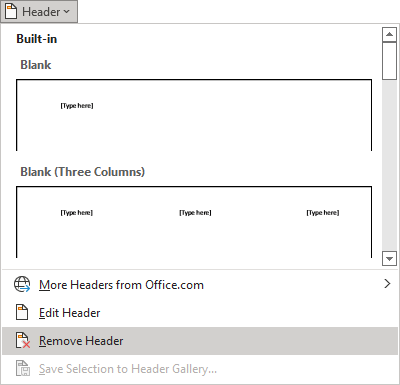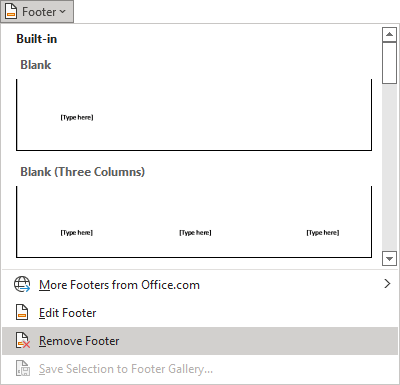Working with headers and footers
The text or images such as logos, inserted in the Header or Footer, should repeat on each page of the document, excluding cases when there are:
- different headers and footers for odd and even pages:

- different headers and footers for different sections of the document:

Add header or footer to the document
To add a header or footer to the entire document, follow these steps:
1. On the Insert tab, in the Header & Footer group, choose Header or Footer:
 or
or

2. Choose the predefined header or footer from the gallery. Hover the mouse pointer over a header to see a description:

Click the Edit Header (or Edit Footer) button to insert a custom header or footer content.
Word inserts the header or footer, displays the header or footer area if the current view wasn't displaying it, adds the Header & Footer tab:

3. Add the elements from the Header & Footer tab or select one of the AutoTexts.
Note that you can add more than one line of text. Format the text just like any other text, and use the Tab key and spacebar or the alignment buttons on the Formatting toolbar to position it.
See how to use the document information in headers and footers.
4. To remove a content control, right-click it, and then choose Remove Content Control from the context menu:

5. After changing the header or footer content, return to the Header & Footer tab and in the Close group, choose Close Header And Footer or press either Esc or Alt+Shift+C. Word closes the header and footer area for editing, returning you to the document's main text.
Note: You can also double-click in the main text to return to it from the header or footer. Likewise, if you can see the header or footer area, you can double-click on it to switch to the Header & Footer edit mode.
Navigating among headers and footers
To move from the header area to the footer area, on the Header & Footer tab, in the Navigation group, choose Go to Footer or Go to Header. Alternatively, press ↓ (upper arrow) from the last line of the header or ↑ (down arrow) from the first line of the footer:
 or
or

Click the Next button to move to the header or footer area of the next section.
Click the Previous button to move to the header or footer area of the previous section.
Edit and format headers and footers
To display and edit an existing header or footer quickly, double-click the dimmed header or footer in Print Layout view.
To insert document information such as a document title, author or responsible person name, date of the last modification, etc., in headers and footers, see Use the document information in the header and footer.
See how to insert the current heading with some level in the header or footer.
To format headers and footers, on the Design tab:
- In the Options group, do any of the following:

- Select the Different First Page check box if you want to use a different header or footer for the document's first page. This option is often used for the document with the first cover page.
- Select the Different Odd & Even Pages check box if you want to use different headers or footers for odd and even pages. See How to create different headers and footers for odd and even pages for more details.
- Clear the Show Document Text check box if you prefer to see headers and footers without the document content. Word hides the document content when you activate a header or footer.
- In the Position group, set the Header from Top or Footer from Bottom distance:

If your document contains section breaks (see Pagination breaks), each subsequent section inherits the headers and footers of the previous section unless you break the link between the two sections. You can create a different header and footer for the current section (see how to create different headers and footers for pages with portrait and landscape orientation in Word).
Display and hide headers and footers
To fit more content on the screen, hide the white space on and between pages, such as top and bottom margins with all information on them. Thus, the pages will not display in a usual way:

See How to hide/show the space between pages.
Remove a header or footer
To remove headers or footers in the document, do one of the following:
- On the Insert tab, in the Header & Footer group, click Header or Footer.
In the appropriate dropdown list, select Remove Header or Remove Footer:
 or
or

- Activate the header or footer (for example, by double-clicking the dimmed header or footer in Print Layout view). Press Ctrl+A to select all the header or footer content, and then press the Delete key.
The header or footer for the current section will be removed.
Note: You need to remove the header and footer for each document section. Also, if you have different headers or footers for even and odd pages, you need to remove each of them.
See also this tip in French: Comment ajouter les en-têtes et les pieds de page dans votre document Word.

